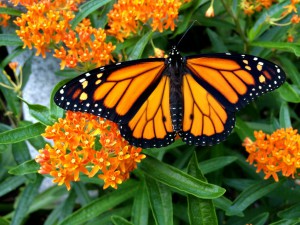Q: My butterfly weed is blooming well and attracting butterflies! What can I do to help it continue to grow?
A: Thank you for contacting us with your milkweed question. First, I’m so happy that your milkweed is thriving and blooming and attracting monarchs. It will attract other butterflies as well, like tiger swallowtails.
These are native plants, and they take care of themselves. Please don’t do anything. (I will have one exception to that at the end of the message.) When monarchs lay eggs on milkweed plants, the larvae hatch and eat the leaves, but sometimes they eat the immature seedpods as well, so it is best to just leave the pods alone and to let them mature on the plant. The pods usually take quite a while to mature. I think the common milkweed may be a little quicker than butterfly weed, but I haven’t seen any mature pods yet. You can just leave them alone, let them mature, and then let the seeds fly off with their accompanying “down.” I had a purple milkweed (quite a rare species that I grew from seed in my basement) whose pods didn’t mature until winter.
Here is the exception. If you have a specific place you want to plant the seeds from your butterfly weed, just keep an eye on the plants and when the pods mature and open naturally, you can remove the pods. You will need to clean the seeds by removing the down; otherwise, they will fly away from the location where you plant them. Just take the pods inside out of the wind, maybe in the garage, remove the down, and then you can plant the seeds where you want them to grow. Here’s another important item. Do not cover the seeds with soil as they need light to germinate. If you do decide to plant them yourself, loosen the soil where you want them to grow, sprinkle the seeds on the soil, and then just pat them firmly into the soil, BUT DON’T COVER THEM. After that, nature should take over. Native plants don’t really need us to do anything much other than to protect them from being overwhelmed by invasive weeds. My guess is that they will be ready to plant in the fall, but I’m not sure about this. You will just need to watch them.
Meredith Tucker

